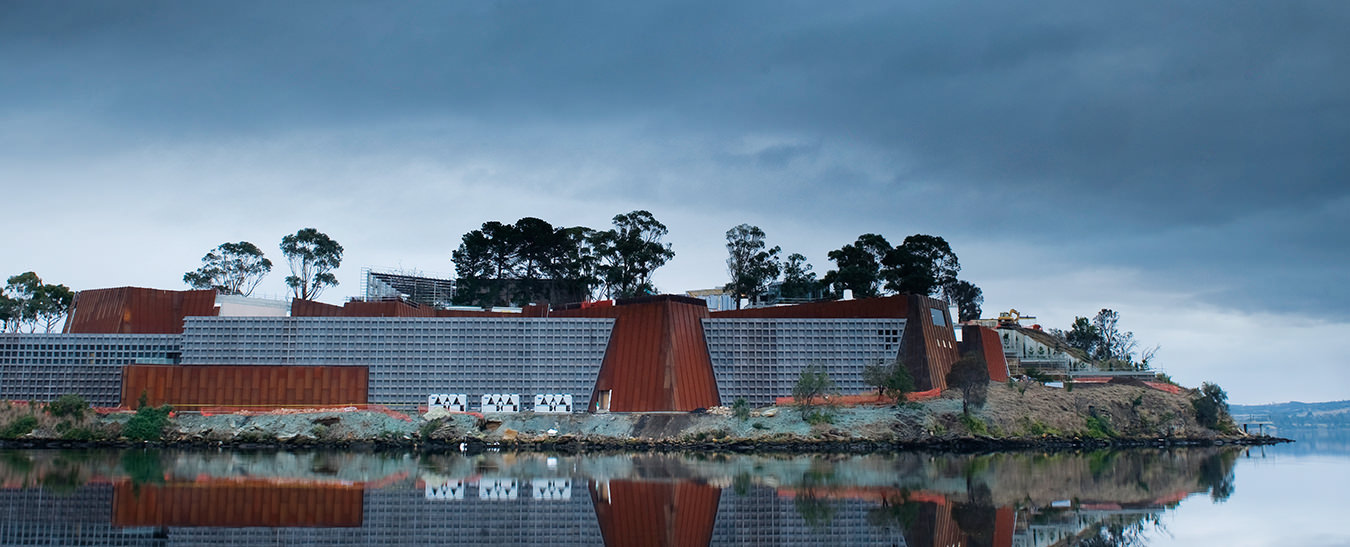Tasmania’s Museum of Old and New Art
An island museum.

“Every man is the builder of a temple,” and art collector David Walsh has created one of mammoth proportions that’s filled with art. On the outskirts of Hobart in Tasmania—a small island off Australia’s southeast coast measuring just 315 kilometres across at its greatest width—is the Museum of Old and New Art (MONA), the largest private art museum in the country. Described by Walsh as his own “secular temple”, MONA lies upon a 3.5-hectare peninsula on the banks of the Derwent River.
The vast collection of Walsh’s antiquities and modern and contemporary art will be featured in displays year-round. The opening exhibition, Monanism, will show a range of artworks by Jean-Michel Basquiat, Jenny Holzer, Anselm Kiefer, Masao Okabe, and the Young British Artists. (Walsh also owns three pieces by Brit wild child Damien Hirst: Beautiful Mis-shapen Purity Clashing Excitedly Outwards Painting [1995]; The Last Supper [2005]; and Cholera, Seed, The Martyrdom of Saint Thomas [2003] from his series the Cancer Chronicles, a striking canvas covered with resin and flies.)
Walsh’s sharp mathematical skills led to incredible gambling success, which made his acquisitions financially possible. (Dropping out of university in the late seventies to count cards, Walsh went on to develop a complex gaming system used for betting, and winning, on horse races.) His art collection, which began with ancient coins, is today worth some serious coin itself: an estimated $100-million Australian ($99-million Canadian).
“Art that appeals most to me says something about existence,” Walsh says. “I love it when I feel an opinion or emotional state is being transferred to me without me being directly aware of it.” In the eclectic range of works on view, it’s not always the most obvious pieces that awaken emotion or self-reflection. For instance, although Chris Ofili’s canvas The Holy Virgin Mary is overtly provocative—the painting incorporates elephant dung—less obtrusive artworks on display also have the ability to create great, or even greater, emotional impact through their subtlety. When a talented artist “expresses [a] point without flourish or pomposity,” as Walsh puts it, sometimes they can strike a nerve much more effectively. Of course, it’s all viewer-dependent, but there’s no question that most museum-goers will leave MONA with opinions to voice, or, at the very least, conversations to start.
A Tasmanian himself, Walsh purchased the property (on which his childhood home overlooked) in 1995, and a few years later opened the Moorilla Museum of Antiquities, a precursor to MONA. In 2005, Walsh started to plan for MONA to better house his growing collection. He brought on board museum director Mark Fraser, previously the managing director and CEO of Sotheby’s Australia, to help execute his vision.
MONA’s exterior may not win over visitors at first impression, but it dazzles upon entrance. Designed by Melbourne architect Nonda Katsalidis, the museum is located 17 metres underground. Walsh’s desire is for museum-goers to be initially underwhelmed before they venture into the bowels of the earth by stairwell or elevator, descending to a 240-million-year-old yellow sandstone wall. A glisten of water may leak down the exposed rock, but it is left there at Walsh’s instruction, one of many elements preserved in the “living wall”, as Walsh calls it, which is as much a piece of art as the rest of the works housed within the museum’s three subterranean levels.
Not without controversy, some artworks on display are extremely daring. The “sex and death gallery” is covered with 7,000 pieces of floor-to-ceiling gold foil and surrounded by one kilometre of red satin curtains. Walk inside and you’ll find Stephen J. Shanabrook’s On the Road to Heaven the Highway to Hell (2008), a chocolate cast of a suicide bomber’s remains; along with Gregory Green’s Bible Bomb #1854 (Russian style) (2005), a mixed media “bomb” in a Bible; among many other pieces.
If sex and death don’t appeal, there is much more to view in other galleries. A great supporter of Australian artists, Walsh called for a redesign of the original museum plans in order to install a 45-metre-long series of 1,620 images—Snake by Sidney Nolan, which has never before hung in the country. In another enormous room lives a machine that requires feeding; the staggering contraption, Cloaca by Belgian artist Wim Delvoye, replicates the human digestive system from beginning to end.
Some may find it difficult to leave such a captivating museum, but not to worry. There’s always the option of having your ashes interred there after death, part of an art installation by Julia DeVille. Walsh muses, “I like the idea of turning them [museum guests] into a piece of art. Their kids or their friends could come along and sit here with a beer or a glass of wine.”
Photo by Matthew Newton.




